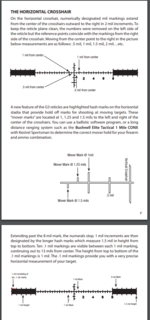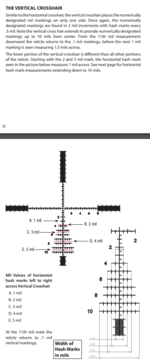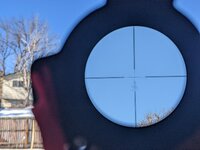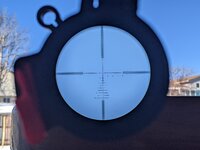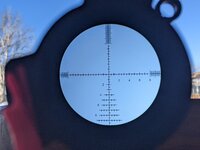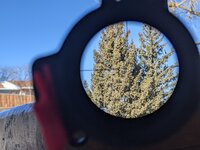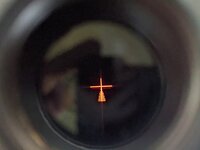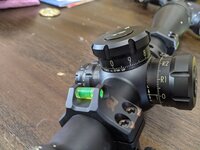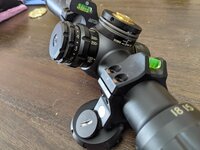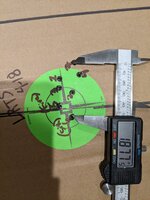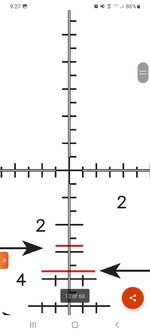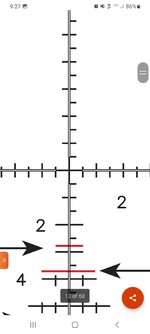sndmn11
"DADDY"
Bushnell LRTSi 4.5-18x44 Drop test/mini evaul. Rifle/mount/rings proofed see here consisting @HawkinsPrecision rings, Tikka T3 action with 22BR barrel from Preferred, in a Bell and Carlson stock. Sight in shots (middle black circle) were low and a little left. Corrections of .2mil up and .2mil right were made, the .2mil right was probably strong, but was left as "zero". This is my own scope purchased used maybe two years ago.
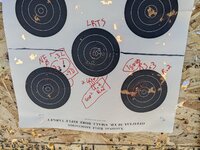
Protocol was as closely adhered to as possible https://www.rokslide.com/forums/threads/scope-field-eval-explanation-and-standards.246775/
~18" drops right/top/left with single shot in between, ~36" drop right/top/left single shot in between, ~36' drop rightx3/topx3/leftx3 single shot. 7 shots with 15 drops.
Results of drops marked shots 1-7 @762Gunner
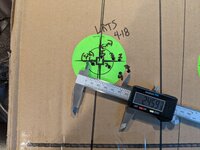
The above drop testing was done outdoors at 100 yards, 20-30deg, off and on wind, and other things needed to be fit into the day. The following day I went to an indoor 100 yard range to do testing of adjustment value tracking and return to zero in a very abbreviated manner.
One shot was taken as a cold bore "zero". I then removed the elevation turret and loosened the "revlimited" zero stop's set screw. I dialed down 5 mil and shot, up 10 mils and shot, down 10 mils and shot, and repeated this for five shots down and five shots up. After the fifth shot up, I dialed down 5 mils and shot at the "zero" spot again for hot zero confirmation.
*The indoor range has some sort of mat at various distances downrange, I think it covers light fixtures on the ground, but the RO told me the edges were thin and had nothing behind them. I knew that the 5 mil down adjustment was close to the corner of a mat, see picture below. Being that I had a lot to get done in my scheduled hour, I wishfully hoped it would not interfere. I was wrong. @BjornF16 noticed in another thread some keyholes in the target, and they are from the 5 mil down shots striking the mat and presumably tumbling. One made it through after the others had cleared a path, and it measured ~1' 5 21/32" while being in a straight line that bisected the aiming point and met with the upper 5mil adjustment.
I did not realize this until after I had removed the LRTSi, mounted the SHV and tested it, and then brought the target back. So the LRTSi was remounted, a "cold" zero shot at the previous green spot, and 5 mil adjustment down was made. After each of these five shots, I dialed up 10 mils to simulate the prior test but did not shoot, and then went back to the zero target for a second "hot" zero confirmation. This is why there are four holes in the 100 yards LRTSi zero spot.
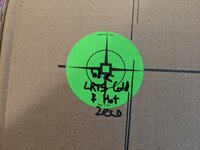
5 mils shold be 18" (1' 6")
Dialing up came to ~1' 5 13/32"
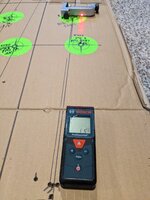
The lone survivor of getting through the barrier at ~1' 5 21/32"
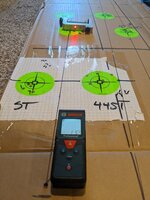
Re-try at a different aiming point dialing down ~1' 5 7/16"
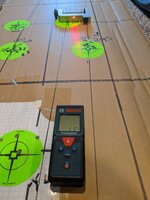
Scope view of the barrier's corner...I'm a dummy
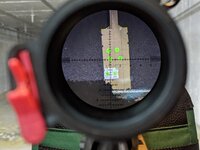
I DID NOT follow the full 10 shot return to zero protocol for a few reasons. 1) I was running shot on time. 2) I have 30 cartridges loaded that were among the batch of 300 on virgin brass. In the event I need to retest the SHV or Maven RS.3, I do not know if something will change with once fired brass. 3) I own this scope and can share results later. 4) @Formidilosus probably has oodles of data as well, and nothing went wonky with this scope and the tests I went through. In other words, things were working and I accepted that.
Some will notice multiple "plum" lines on the cardboard, The indoor range is multiple lanes with cable/track target carriers to run the targets to the end. I did take a level and stapled the target up plum/level, but by the time it settled at the end, it was not plum. I have multiple levels on the scope, and used those to shoot. For the 5mil up and 5mil down shots, a straight line can be made from those two groups bisecting the green circle aiming point. I drew the line to show this. I think my logic is sound in that if the scope tracked in a curve, a straight line could not be made between the three points. This is also why I stopped because the best test would be on a plumed target like I can do at the outdoor range.

Protocol was as closely adhered to as possible https://www.rokslide.com/forums/threads/scope-field-eval-explanation-and-standards.246775/
~18" drops right/top/left with single shot in between, ~36" drop right/top/left single shot in between, ~36' drop rightx3/topx3/leftx3 single shot. 7 shots with 15 drops.
Results of drops marked shots 1-7 @762Gunner

The above drop testing was done outdoors at 100 yards, 20-30deg, off and on wind, and other things needed to be fit into the day. The following day I went to an indoor 100 yard range to do testing of adjustment value tracking and return to zero in a very abbreviated manner.
One shot was taken as a cold bore "zero". I then removed the elevation turret and loosened the "revlimited" zero stop's set screw. I dialed down 5 mil and shot, up 10 mils and shot, down 10 mils and shot, and repeated this for five shots down and five shots up. After the fifth shot up, I dialed down 5 mils and shot at the "zero" spot again for hot zero confirmation.
*The indoor range has some sort of mat at various distances downrange, I think it covers light fixtures on the ground, but the RO told me the edges were thin and had nothing behind them. I knew that the 5 mil down adjustment was close to the corner of a mat, see picture below. Being that I had a lot to get done in my scheduled hour, I wishfully hoped it would not interfere. I was wrong. @BjornF16 noticed in another thread some keyholes in the target, and they are from the 5 mil down shots striking the mat and presumably tumbling. One made it through after the others had cleared a path, and it measured ~1' 5 21/32" while being in a straight line that bisected the aiming point and met with the upper 5mil adjustment.
I did not realize this until after I had removed the LRTSi, mounted the SHV and tested it, and then brought the target back. So the LRTSi was remounted, a "cold" zero shot at the previous green spot, and 5 mil adjustment down was made. After each of these five shots, I dialed up 10 mils to simulate the prior test but did not shoot, and then went back to the zero target for a second "hot" zero confirmation. This is why there are four holes in the 100 yards LRTSi zero spot.

5 mils shold be 18" (1' 6")
Dialing up came to ~1' 5 13/32"

The lone survivor of getting through the barrier at ~1' 5 21/32"

Re-try at a different aiming point dialing down ~1' 5 7/16"

Scope view of the barrier's corner...I'm a dummy

I DID NOT follow the full 10 shot return to zero protocol for a few reasons. 1) I was running shot on time. 2) I have 30 cartridges loaded that were among the batch of 300 on virgin brass. In the event I need to retest the SHV or Maven RS.3, I do not know if something will change with once fired brass. 3) I own this scope and can share results later. 4) @Formidilosus probably has oodles of data as well, and nothing went wonky with this scope and the tests I went through. In other words, things were working and I accepted that.
Some will notice multiple "plum" lines on the cardboard, The indoor range is multiple lanes with cable/track target carriers to run the targets to the end. I did take a level and stapled the target up plum/level, but by the time it settled at the end, it was not plum. I have multiple levels on the scope, and used those to shoot. For the 5mil up and 5mil down shots, a straight line can be made from those two groups bisecting the green circle aiming point. I drew the line to show this. I think my logic is sound in that if the scope tracked in a curve, a straight line could not be made between the three points. This is also why I stopped because the best test would be on a plumed target like I can do at the outdoor range.
Last edited:

